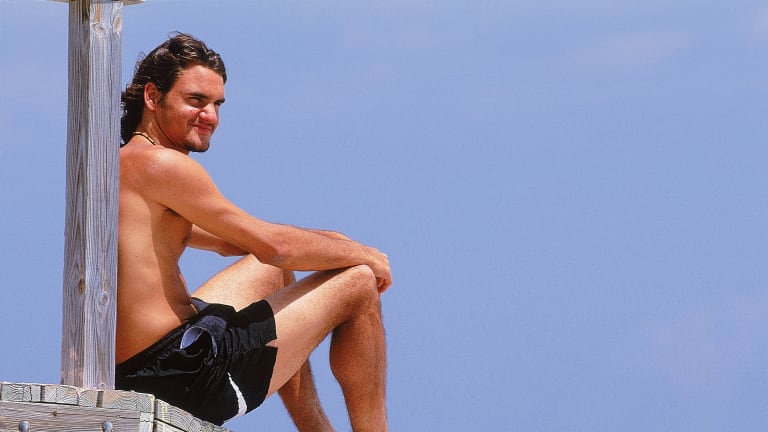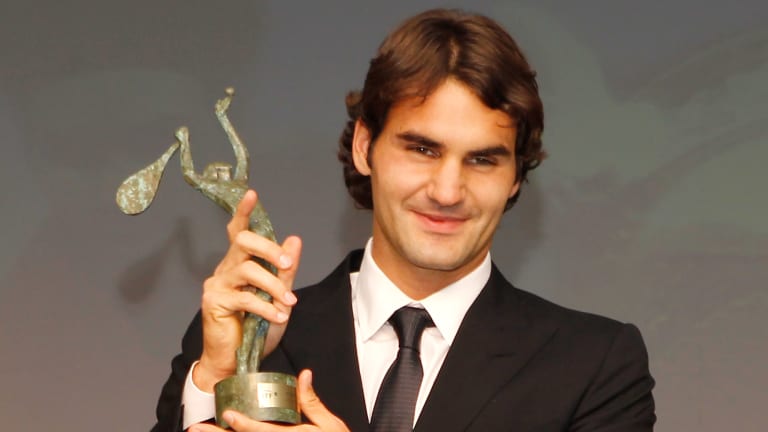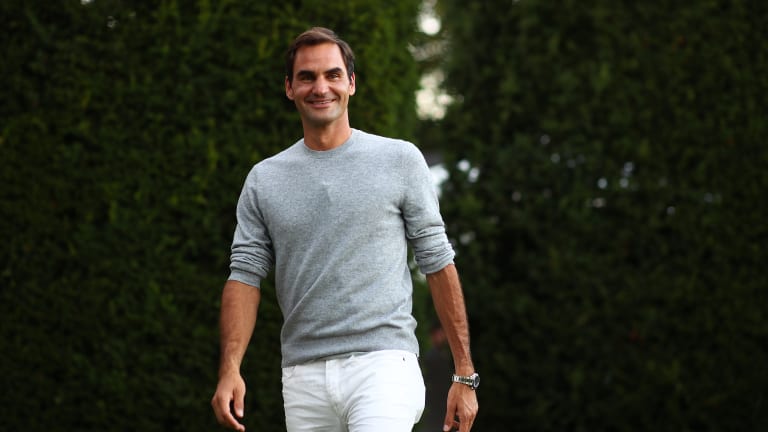Federer Turns 40
The Rally: 20-plus years in the making, how writing The Master humanized Federer for its author
By Steve Tignor Aug 08, 2021Federer Turns 40
Roger Federer: "At the moment, everything is still a little bit uncertain"
By Kamakshi Tandon Aug 13, 2021Federer Turns 40
The Rally: What the August exodus of Djokovic, Nadal, Federer and Serena means for summer hard-court tennis
By Joel Drucker and Steve Tignor Aug 11, 2021Federer Turns 40
Roger Federer: The second 40-something to rank in the Top 10
By John Berkok Aug 08, 2021Federer Turns 40
What makes Roger Federer so fascinating at 40?
By Joel Drucker Aug 08, 2021Stat of the Day
Casper Ruud has become the first tennis player, male or female, to win 30 matches this year
By John Berkok Apr 27, 2024Your Game
Racquet Review: Head Boom MP 2024
By Jon Levey Apr 27, 2024Breaking News
Alizé Cornet announces that she'll retire from tennis after Roland Garros
By TENNIS.com Apr 27, 2024Lifestyle
Venus Williams honored by Cultured magazine for on- and off-court cultural impact
By Baseline Staff Apr 27, 2024Madrid, Spain
Rafa's revenge! Rafael Nadal conquers Alex de Minaur in gritty Madrid battle
By TENNIS.com Apr 27, 2024Federer Turns 40
The Rally: 20-plus years in the making, how writing The Master humanized Federer for its author
Look who turns 40 today: Roger Federer. Christopher Clarey, New York Times sports reporter and author of The Master—his new biography of the Swiss great due out August 24—joins for a special edition of The Rally.
Published Aug 08, 2021
Advertising
Poetry in motion: Federer's footwork
Chris,
You probably didn’t plan it this way when you began your book, but this may be a propitious moment to release a Roger Federer biography. He’s turning 40 today. He’s coming off a reality-check defeat at Wimbledon. And he has sounded unsure recently about how much longer he plans to play. Which means your new book, The Master, may serve as the first full-fledged overview of his career just as it is winding to a close.
I’ve been waiting for a Federer bio to come out in the U.S. for a while now. For someone who has regularly appeared on our TV sets for 20 years, and who has been interviewed thousands of times, Federer can still seem like a bit of a mystery, at least in the States, or at least to me.
Unlike Rafael Nadal, he hasn’t yet written an autobiography. His wife, Mirka, as you note in The Master, doesn’t speak to the press, and Federer himself generally keeps his private life private. There’s also something about his game, and where it came from, that eludes our customary explanations for sporting genius. Federer’s parents weren’t professional athletes; Switzerland has little history of producing great men’s players; he isn’t a tortured artist, like, say, John McEnroe; and he didn’t have to fight his way out of difficult circumstances.
If anything, the opposite was true. One revelation of your book for me is how much Federer’s early instructors, recognizing his talent, bent over backwards to accommodate his emotional volatility and lack of attention span. They even brought in a juggler to keep him entertained. As one of his coaches, Paul Dorochenko, told you, “Nobody made Federer fit into a mold. A mold was made to fit Federer.”
With The Master, I’d say you go as far as anyone has toward explaining Federer’s personality, and how it led to his success. I’ll start by mentioning a story that stood out for me, and that I didn’t know the details of before: The death of Peter Carter, the Australian coach who believed in Federer’s talent more than anyone else, who essentially constructed his game, and who died in a car accident on his honeymoon in South Africa in 2002. I hadn’t realized that Federer and his family had urged Carter to take that trip (Federer’s mother, Lynette, is South African), or the mix of guilt and grief Federer felt after Carter’s death. It seems to have been a turning point for him, and to have given him a greater sense of purpose. From then on, Federer dedicated himself to becoming the player Carter believed he could be, and he won the first of his 20 Slams the following summer. This story also goes some way to answering a question I’ve asked myself about Federer in the past: How did the intense emotionalism he displayed as a kid relate to his success as an adult? His deep feeling for Carter, and how he channeled it, is one answer.
Chris, you’ve covered Federer since he appeared on tour in the late 1990s. How did the experience of writing this book change or affect your view of him?
Advertising

Federer at the beach in Key Biscayne, March 2000.
© Getty Images
Steve,
Thanks for the opportunity to exchange groundstrokes. The Master was more than 20 years in the making for me. It started when I took an agent’s advice and found a spot in the press seats on Court Suzanne Lenglen at the 1999 French Open, where Federer made his Grand Slam debut and lost to Patrick Rafter. “This kid is special” was the gist of the agent’s recommendation, “and I don’t represent him so you can trust me on this one.”
Federer already was fluid and flashy, but he was still volatile then. You definitely knew the score from his body language. He was also not nearly as chic with his baggy, Sampras-inspired clothes and his backward ball cap. Covering his transformation through the years has been both a privilege and a challenge. In some ways, he’s an open book: he has given the fans, the sport and the media so much of himself. My employers—the New York Times and the late, great International Herald Tribune—were big beneficiaries as he granted me a remarkable amount of access, beginning in the early 2000s, in part because of his interest in making inroads in the US market. I got the chance to interview Federer everywhere from a private plane to the front seat of his Mercedes in the Swiss Alps. He is very good company, in part because he likes to know where his inquisitors are coming from (both literally and figuratively). He has a knack for making an interview feel like a conversation, which is something journalists, not athletes, usually aim for. He is also a tennis nerd: someone who follows the sport and its trends and storylines very closely.
But as you point out, he has a closed-book side, too. He has learned the value of controlling the flow of information from his team, particularly from his fitness trainer Pierre Paganini, and has also kept a tight lid on his private life. Unlike say Jelena Djokovic, Mirka Federer is non-existent on social media and essentially stopped giving interviews 15 years or so ago despite being a very strong personality and former top 100 player. This is more the norm than the exception for the wives of elite men’s players, and it contributes to Federer’s life remaining neatly compartmentalized, which is just the way he likes it. It’s about conserving energy and enthusiasm for when he enters each of those compartments.
The decision to spend a year researching and writing The Master came partly from a desire to chronicle in depth a golden era in men’s tennis but also from a desire to understand more about Federer’s process. His methods have allowed him to thrive in and out of the spotlight for nearly 20 years and to play until age 40 although we will see how much more competitive tennis he actually plays at age 40. Even if he does play on, I feel his main body of work is now complete, which is another reason I decided to write The Master at this stage. I wanted to learn more about the key figures in his journey: Peter Carter, Peter Lundgren, Paganini, Mirka and Federer’s underrated longtime coach and confidante Severin Lüthi. Another objective was to dig back into Federer’s rivalries and not just the Big Three/Four duels. Andy Roddick and Marat Safin were particularly good on what it was like to face Federer, and Safin is one of the best compare-and-contrast options available because he, too, had next-level talent but lacked the other traits—innate or acquired—that allowed Federer to make a good run at maximizing his own abilities. They both had their demons and their frustration-management issues, but only Federer was able to find a way to use all that emotion for long-running fuel. Working on the book helped me understand just how challenging that was for him and that it took a tragedy—Carter’s death in 2002—to give him clarity. Federer definitely worked the problem before then: seeing a young Swiss psychologist Christian Marcolli, who also spoke with me for the book. But Carter’s death gave Federer the higher cause he was lacking. Carter’s Australian coach Peter Smith choked up in our interview as he described the email that Federer sent to him after Carter’s accident. It was a mission statement, and I think it’s safe to say that Federer fulfilled the mission.
To answer your question directly (and belatedly) I think writing The Master fully humanized Federer for me. To borrow the duck metaphor, I I feel like I’ve gotten a much deeper understanding of how much paddling was happening beneath the smooth surface of the water. That does not diminish his achievements. Quite the contrary.
Advertising

Federer at the ITF World Champions Gala, June 2010.
© 2010 Getty Images
Chris,
You did a great job gathering and marshaling a lot of information. It may not get mentioned on the cover, or in the promotion for this book, but you spend a fair amount of time profiling Federer’s biggest rivals, and narrating his era. I liked being reminded of what a talent and a character Safin was; I’m not sure I knew that he and Federer spent so much time together in their early playing days. I also thought you did a good job of filling in Nadal’s backstory and summing up his relationship with Federer.
And as you say, your interviews with Federer are always revealing. Most interviews with him are, because he rarely limits his comments strictly to the topic at hand, and there seems to be a porous filter between what goes through his head and what comes out of his mouth. I think fans of his will enjoy your accounts of your trips with him and talks with him. Interesting that when he’s in a group of friends and business colleagues, Federer will spend as much time listening as he does talking.
There were two seemingly small anecdotes about Federer in the book that I thought were revealing.
As a teenager, before he turned pro, Federer told his dentist that he had dropped out of school to pursue tennis full-time. His dentist, in good conservative Swiss style, scoffed at the idea. Federer’s response? Get a new dentist. He may be an unassuming person, and he may have been a somewhat lazy athlete when he was younger, but he always harbored global-sized ambitions. Federer speaks half the languages of Europe, but that early willingness to take a risk on himself struck me as highly American. He also understood the value of surrounding himself with people who wouldn’t make him doubt his goals or his ability to achieve them.
Later in the book, you take a 7:00 A.M. flight with Federer from sunny California to wintry Chicago for business. For a lot of us, this would be the height of drudgery and—even on a private jet—the downside of a life lived on the road. But not for Federer.
“Think about today,” he says. “We left with the sunrise, beautiful weather in Indian Wells, and we get here, and it’s cold and a totally different vibe. That’s the beauty of travel, of seeing different places. I love it. I do. I still love it.”
Federer seems like someone who is good at appreciating what’s around him, and retaining his sense of wonder about it all. On a few occasions, when he’s been asked about a past match, I’ve heard him mention that he enjoyed the weather that day—the sight of the sun setting over the court, or a storm he could see coming in the distance. As you say in the book, “jaded” has never been in his vocabulary.
But even Federer will have to leave the road at some point. Not only does he turn 40 today, but we also received news this week that he won’t play in Canada or Cincinnati. And I don’t know about you, but I felt like he was, unfortunately, something of a figure from the past at Wimbledon this year. Two of his favorite American athletes, Pete Sampras and Michael Jordan, went out in a blaze of glory, but it doesn’t look like that will be in the cards for Federer. Which makes your book valuable as a way to remind us, in case we’ve started to forget, of how special his career really was.
Chris, is there something you hope that readers will learn about Federer from The Master that they might not have thought or realized about him before?
Advertising

Federer takes a stroll in Geneva, September 2019.
© Getty Images for Laver Cup
Steve,
Tennis stars can be a finicky lot. It’s an individual sport, after all, despite all the focus on teams in recent years, and the lion’s share of the benefits accrue to only a few players. They quickly grow accustomed to being catered to, and you can often hear the squeak of the sneakers dragging when they are asked to fulfill outside commitments: be it interviews or appearances. But what struck me about Federer as I researched was how much he embraced all aspects of his profession, and as he hits 40, I think that really has been one of the keys to his longevity. He has a finely tuned negative-energy detector, exemplified by the story you mention about his dentist in Basel. He likes positive people who think constructively.
But that affinity for the upbeat could also have led him astray by encouraging him to dodge some of the thornier aspects of being a tennis professional. Instead, he tackled it all and learned to find enjoyment and meaning in the domains that might not have been his natural habitats. His decision to operate without a formal agent in the early 2000s is a good example. He did not want to be passive about his finances and business decisions. He wanted to dig into that world that many athletes leave largely to others. He also got involved with the ATP player council and prize-money negotiations at the peak of his powers when the previous generation of men’s stars—Sampras, Agassi and Becker—had left such matters to lesser lights. Federer wanted to be fluent in all aspects of the game and in the process I think he came to enjoy the game even more.
There is certainly a lot of nature over nurture here, too. His playful personality, gregariousness, empathy and curiosity were there from the beginning. Those qualities certainly helped him thrive in the traveling tennis circus (So of course did all the millions he earned, allowing him and Mirka to voyage in style and with plenty of support staff for their growing family). But Federer has also been very intentional, understanding what he needed to remain mentally fresh: novelty, variety, genuine breaks, new cities, new projects like the Laver Cup, new influences like Bill Gates. It is as if he plans for being in the moment, which is something I think all of us can learn from him. We cannot copy his hand-eye coordination or grace on the move, but we can strive to give our full attention to whatever task we face and to find if not joy then at least satisfaction in it.
Click here to pre-order your copy of The Master, out August 24.